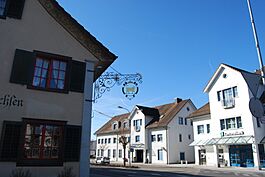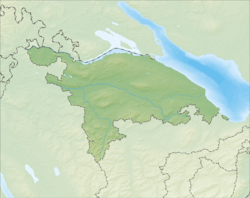Müllheim, Switzerland facts for kids
Quick facts for kids
Müllheim
|
||
|---|---|---|
 |
||
|
||
| Country | Switzerland | |
| Canton | Thurgau | |
| District | Frauenfeld | |
| Area | ||
| • Total | 8.74 km2 (3.37 sq mi) | |
| Elevation | 413 m (1,355 ft) | |
| Population
(Dec 2020 )
|
||
| • Total | 3,002 | |
| • Density | 343.48/km2 (889.6/sq mi) | |
| Postal code |
8555
|
|
| Surrounded by | Amlikon-Bissegg, Homburg, Hüttlingen, Pfyn, Wigoltingen | |
Müllheim is a cool town, or 'municipality,' located in the Thurgau canton of Switzerland. It's part of the Frauenfeld District.
Contents
History of Müllheim
Müllheim was first mentioned in official records way back in 1254. In the 1200s and 1300s, a family of knights called the Müllheim family lived here. These knights were called Ministerialis. They served powerful lords.
At first, the Kyburg family owned the area around Müllheim. When their family line ended, the Habsburgs took over. Later, in 1460, Reichenau Abbey bought the rights to the village.
The abbey and later the Bishop of Constance were the main rulers. They controlled the laws and land in the village until 1798. The village itself could even give out small fines and punishments.
The village church was likely built around 1340. It was part of the Pfyn area. In 1528, the Protestant Reformation arrived. Many villagers changed their religion to Protestantism.
For a while, the church of St. Verena was used by both Catholics and Protestants. This continued until a new Catholic Church was built in 1967. Over time, more people in Müllheim became part of the Swiss Reformed Church.
The economy of Müllheim used to be all about farming. People grew grapes for wine, fruits, and plants like flax and hemp. They also focused on forestry, dairy farming, and making cheese.
The Müllheim-Wigoltingen railway station opened in 1855. This helped new factories to start up. A canvas factory opened in 1857. Later, a tool factory called Utilis Müllheim started in 1870. Today, companies in Müllheim make steel furniture and recycle industrial waste.
Geography of Müllheim
Müllheim covers an area of about 8.74 square kilometers (3.37 square miles). Almost half of this land, about 49.8%, is used for farming. Forests cover about 29.3% of the area.
Buildings and roads take up about 18.8% of the land. A small part, about 2.1%, is made up of rivers or lakes. Most of the water in Müllheim is flowing water.
The town is located in the Frauenfeld District. It sits on the southern edge of the Seerücken hills. Müllheim includes the main village and smaller areas called hamlets, like Maltbach, Grüneck, and Langenhart.
Population of Müllheim
Müllheim has a population of about 2,676 people. About 13.5% of the people living here are from other countries. Over the last ten years, the population has grown by about 11%.
Most people in Müllheim, about 89.3%, speak German. Albanian is the second most common language, spoken by 3.0% of the population. Italian is third, spoken by 2.5%.
In 2009, about 10.8% of the population were children aged 0-9. Teenagers aged 10-19 made up about 14.7%. Adults aged 20-59 made up a larger part of the population. Older adults, aged 60 and above, made up about 17.7% of the population.
Here's how the population has changed over time:
| year | population |
|---|---|
| 1850 | 873 |
| 1860 | 1,144 |
| 1870 | 904 |
| 1880 | 1,281 |
| 1890 | 1,385 |
| 1900 | 1,464 |
| 1950 | 1,541 |
| 1960 | 1,511 |
| 1980 | 1,541 |
| 1990 | 1,888 |
| 2000 | 2,398 |
Cool Places to See
The area known as Grüneck is a special place. It's recognized as part of the Inventory of Swiss Heritage Sites. This means it has important historical or cultural value.
Economy and Jobs
In 2007, Müllheim had a low unemployment rate of 1.63%. This means most people who wanted jobs had them.
Many people work in different types of jobs:
- Primary sector: About 75 people work in farming, forestry, or fishing. There are 29 businesses in this area.
- Secondary sector: About 316 people work in factories or construction. There are 30 businesses here.
- Tertiary sector: About 402 people work in services, like shops, restaurants, or offices. There are 76 businesses in this sector.
Many people who live in Müllheim travel outside the town for work. About 54.6% of residents work in other places. However, about 401 people come into Müllheim for their jobs.
Most people get to work by car (56.4%). About 8.6% use public transportation like trains or buses.
Religion in Müllheim
Based on a 2000 survey, here's a look at the religious groups in Müllheim:
- About 29.6% of people were Roman Catholic.
- About 47.3% belonged to the Swiss Reformed Church.
- A small number of people belonged to other Christian churches, including the Christian Catholic faith and the Orthodox Church.
- About 6.34% of the population were Islamic.
- A small number of people belonged to other faiths or chose not to state a religion.
Education in Müllheim
Müllheim has its own primary and secondary school districts. About 72% of adults (aged 25-64) in Müllheim have finished high school or gone on to higher education, like university.
In the primary school district, there are 256 students.
- There are 55 children in kindergarten.
- There are 101 children in the lower primary grades.
- There are 100 children in the upper primary grades.
In the secondary school district, there are 194 students. Students are grouped based on how well they learn.
- About 111 teenagers are in the advanced school.
- About 74 teenagers are in the standard school.
- A small number of teenagers are in special support classes.
The average class size for all secondary classes is about 18.5 students.
Transport
The Müllheim-Wigoltingen railway station is an important stop. It's part of the Zürich S-Bahn train services, specifically the S8 and S30 lines. This makes it easy for people to travel to and from Müllheim.
See also
 In Spanish: Müllheim (Turgovia) para niños
In Spanish: Müllheim (Turgovia) para niños





